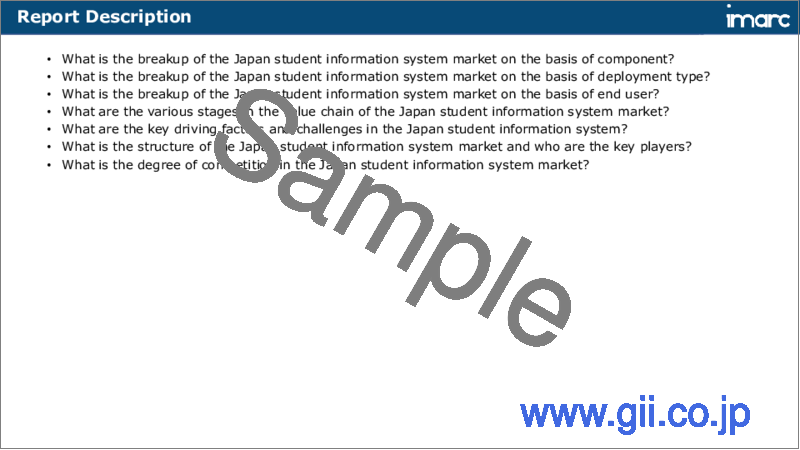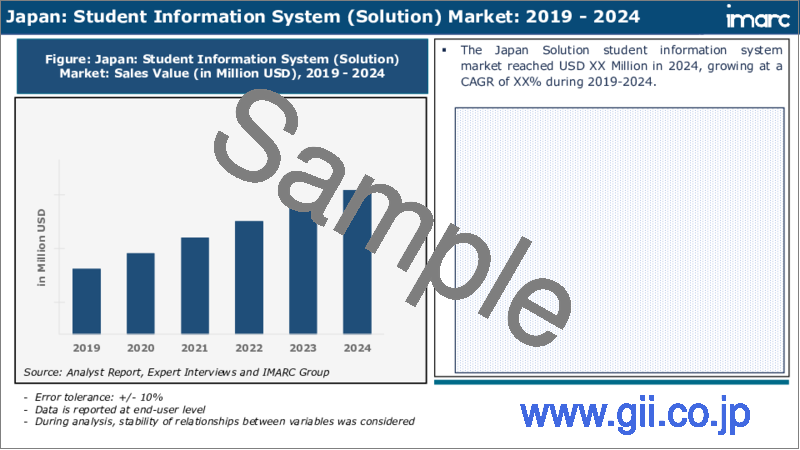|
|
市場調査レポート
商品コード
1747063
日本の学生情報システム市場の分析:コンポーネント別、展開方式別、エンドユーザー別、地域別(2025~2033年)Japan Student Information System Market Report by Component (Solution, Services), Deployment Type (On-premises, Cloud-based), End User (K-12, Higher Education), and Region 2025-2033 |
||||||
カスタマイズ可能
|
|||||||
| 日本の学生情報システム市場の分析:コンポーネント別、展開方式別、エンドユーザー別、地域別(2025~2033年) |
|
出版日: 2025年06月02日
発行: IMARC
ページ情報: 英文 120 Pages
納期: 5~7営業日
|
全表示
- 概要
- 目次
日本の学生情報システムの市場規模は2024年に6億7,580万米ドルに達しました。今後、IMARC Groupは、同市場が2033年までに25億3,040万米ドルに達し、2025~2033年の成長率(CAGR)は14.4%に達すると予測しています。デジタル学習ツールやオンライン教育の普及により、デジタル環境で生徒のデータ管理、入学管理、成績追跡を行う堅牢な学生情報システムソリューションのニーズが高まっていることが、主に市場を牽引しています。
当レポートで扱う主な質問
- 日本の学生情報システム市場はこれまでどのように推移してきたか?
- COVID-19は日本の学生情報システム市場にどのような影響を与えたか?
- 日本の学生情報システム市場のコンポーネント別の内訳は?
- 日本の学生情報システム市場の展開方式別の内訳は?
- 日本の学生情報システム市場のエンドユーザー別の内訳は?
- 日本の学生情報システム市場のバリューチェーンにおける各ステージとは?
- 日本の学生情報システムの主要な促進要因と課題は何か?
- 日本の学生情報システム市場の構造と主要企業は?
- 日本の学生情報システム市場における競合の程度は?
目次
第1章 序文
第2章 分析範囲・手法
- 分析目的
- ステークホルダー
- データソース
- 市場推定
- 分析手法
第3章 エグゼクティブサマリー
第4章 日本の学生情報システム市場:概要
- 概要
- 市場力学
- 業界動向
- 競合情報
第5章 日本の学生情報システム市場の情勢
- 過去・現在の市場動向(2019~2024年)
- 市場予測(2025~2033年)
第6章 日本の学生情報システム市場:コンポーネント別の内訳
- ソリューション
- サービス
第7章 日本の学生情報システム市場:展開方式別の内訳
- オンプレミス
- クラウドベース
第8章 日本の学生情報システム市場:エンドユーザー別の内訳
- K-12
- 高等教育
第9章 日本の学生情報システム市場:競合情勢
- 概要
- 市場構造
- 市場企業のポジショニング
- 主要な成功戦略
- 競合ダッシュボード
- 企業評価象限
第10章 主要企業のプロファイル
第11章 日本の学生情報システム市場:業界分析
- 促進要因・抑制要因・機会
- ポーターのファイブフォース分析
- バリューチェーン分析
第12章 付録
Japan student information system market size reached USD 675.8 Million in 2024. Looking forward, IMARC Group expects the market to reach USD 2,530.4 Million by 2033, exhibiting a growth rate (CAGR) of 14.4% during 2025-2033. The growing adoption of digital learning tools and online education, which has created a need for robust student information system solutions to manage student data, enrollment, and performance tracking in a digital environment, is primarily driving the market.
A student information system (SIS) is a comprehensive software solution designed to manage and organize various aspects of a school or educational institution's administrative processes. It serves as a centralized database to store and retrieve information related to students, faculty, courses, and academic records. Key features of an SIS include student registration and enrollment, grade tracking, attendance monitoring, class scheduling, and communication tools for teachers, students, and parents. It helps streamline administrative tasks, improves data accuracy, and enhances communication among stakeholders. Additionally, an SIS often provides analytical tools for educators to assess student performance and identify areas for improvement. It plays a crucial role in reporting, ensuring compliance with regulatory requirements, and facilitating data-driven decision-making in educational institutions. Overall, an SIS simplifies and automates many administrative functions in the education sector, contributing to more efficient operations and improved student outcomes.
Japan Student Information System Market Trends:
The student information system market in Japan is witnessing robust growth, primarily due to several key drivers that have propelled its adoption across educational institutions. Firstly, the digital transformation of the education sector has been a pivotal factor. With the increasing use of technology in classrooms, institutions are seeking efficient SIS solutions to streamline administrative tasks, enhance data management, and improve overall operational efficiency. Furthermore, the growing emphasis on data-driven decision-making in education has fueled the demand for SIS systems, as they offer valuable insights into student performance and engagement. In addition to this, the inflating need for remote learning solutions has made SIS platforms indispensable for tracking student progress in virtual classrooms. Furthermore, government initiatives aimed at improving education infrastructure and outcomes have encouraged educational institutions to invest in modern SIS solutions. Lastly, the increasing competition among institutions to attract and retain students is expected to drive the regional student information system market, as it enables better communication and engagement with students and parents.
Japan Student Information System Market Segmentation:
Component Insights:
- Solution
- Enrollment
- Academics
- Financial Aid
- Billing
- Services
- Professional Services
- Managed Services
Deployment Type Insights:
- On-premises
- Cloud-based
End User Insights:
- K-12
- Higher Education
Competitive Landscape:
The market research report has also provided a comprehensive analysis of the competitive landscape. Competitive analysis such as market structure, key player positioning, top winning strategies, competitive dashboard, and company evaluation quadrant has been covered in the report. Also, detailed profiles of all major companies have been provided.
Key Questions Answered in This Report:
- How has the Japan student information system market performed so far and how will it perform in the coming years?
- What has been the impact of COVID-19 on the Japan student information system market?
- What is the breakup of the Japan student information system market on the basis of component?
- What is the breakup of the Japan student information system market on the basis of deployment type?
- What is the breakup of the Japan student information system market on the basis of end user?
- What are the various stages in the value chain of the Japan student information system market?
- What are the key driving factors and challenges in the Japan student information system?
- What is the structure of the Japan student information system market and who are the key players?
- What is the degree of competition in the Japan student information system market?
Table of Contents
1 Preface
2 Scope and Methodology
- 2.1 Objectives of the Study
- 2.2 Stakeholders
- 2.3 Data Sources
- 2.3.1 Primary Sources
- 2.3.2 Secondary Sources
- 2.4 Market Estimation
- 2.4.1 Bottom-Up Approach
- 2.4.2 Top-Down Approach
- 2.5 Forecasting Methodology
3 Executive Summary
4 Japan Student Information System Market - Introduction
- 4.1 Overview
- 4.2 Market Dynamics
- 4.3 Industry Trends
- 4.4 Competitive Intelligence
5 Japan Student Information System Market Landscape
- 5.1 Historical and Current Market Trends (2019-2024)
- 5.2 Market Forecast (2025-2033)
6 Japan Student Information System Market - Breakup by Component
- 6.1 Solution
- 6.1.1 Overview
- 6.1.2 Historical and Current Market Trends (2019-2024)
- 6.1.3 Market Segmentation
- 6.1.3.1 Enrollment
- 6.1.3.2 Academics
- 6.1.3.3 Financial Aid
- 6.1.3.4 Billing
- 6.1.4 Market Forecast (2025-2033)
- 6.2 Services
- 6.2.1 Overview
- 6.2.2 Historical and Current Market Trends (2019-2024)
- 6.2.3 Market Segmentation
- 6.2.3.1 Professional Services
- 6.2.3.2 Managed Services
- 6.2.4 Market Forecast (2025-2033)
7 Japan Student Information System Market - Breakup by Deployment Type
- 7.1 On-premises
- 7.1.1 Overview
- 7.1.2 Historical and Current Market Trends (2019-2024)
- 7.1.3 Market Forecast (2025-2033)
- 7.2 Cloud-based
- 7.2.1 Overview
- 7.2.2 Historical and Current Market Trends (2019-2024)
- 7.2.3 Market Forecast (2025-2033)
8 Japan Student Information System Market - Breakup by End User
- 8.1 K-12
- 8.1.1 Overview
- 8.1.2 Historical and Current Market Trends (2019-2024)
- 8.1.3 Market Forecast (2025-2033)
- 8.2 Higher Education
- 8.2.1 Overview
- 8.2.2 Historical and Current Market Trends (2019-2024)
- 8.2.3 Market Forecast (2025-2033)
9 Japan Student Information System Market - Competitive Landscape
- 9.1 Overview
- 9.2 Market Structure
- 9.3 Market Player Positioning
- 9.4 Top Winning Strategies
- 9.5 Competitive Dashboard
- 9.6 Company Evaluation Quadrant
10 Profiles of Key Players
- 10.1 Company A
- 10.1.1 Business Overview
- 10.1.2 Services Offered
- 10.1.3 Business Strategies
- 10.1.4 SWOT Analysis
- 10.1.5 Major News and Events
- 10.2 Company B
- 10.2.1 Business Overview
- 10.2.2 Services Offered
- 10.2.3 Business Strategies
- 10.2.4 SWOT Analysis
- 10.2.5 Major News and Events
- 10.3 Company C
- 10.3.1 Business Overview
- 10.3.2 Services Offered
- 10.3.3 Business Strategies
- 10.3.4 SWOT Analysis
- 10.3.5 Major News and Events
- 10.4 Company D
- 10.4.1 Business Overview
- 10.4.2 Services Offered
- 10.4.3 Business Strategies
- 10.4.4 SWOT Analysis
- 10.4.5 Major News and Events
- 10.5 Company E
- 10.5.1 Business Overview
- 10.5.2 Services Offered
- 10.5.3 Business Strategies
- 10.5.4 SWOT Analysis
- 10.5.5 Major News and Events
11 Japan Student Information System Market - Industry Analysis
- 11.1 Drivers, Restraints, and Opportunities
- 11.1.1 Overview
- 11.1.2 Drivers
- 11.1.3 Restraints
- 11.1.4 Opportunities
- 11.2 Porters Five Forces Analysis
- 11.2.1 Overview
- 11.2.2 Bargaining Power of Buyers
- 11.2.3 Bargaining Power of Suppliers
- 11.2.4 Degree of Competition
- 11.2.5 Threat of New Entrants
- 11.2.6 Threat of Substitutes
- 11.3 Value Chain Analysis






